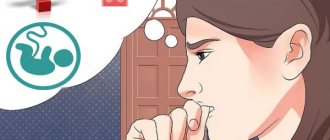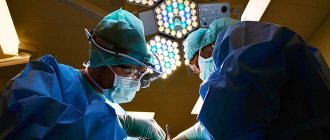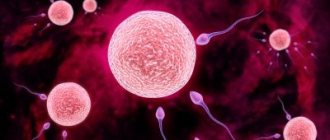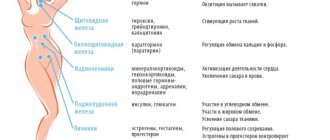Menstruation is the rejection of the functional layer of the endometrium lining the inner surface of the uterus, which has a certain cyclicity. Another name for menstruation is regula (from the word “regular”). The first day of menstruation is considered the beginning of the menstrual cycle - the period during which changes occur in the functioning of the reproductive organs, aimed at the possibility of conception. In a healthy woman, the cycle length is usually 28-30 days. These numbers are the classic norm, but for many women they can fluctuate depending on individual characteristics. Gynecologists consider the acceptable duration of the menstrual cycle to be from 25 to 34 days.
A few days before the start of the regimen, a woman’s health may worsen. Many people complain of increased weakness during this period, decreased performance, and constant drowsiness. Physiological sensations are also possible, for example, headaches, a slight increase in body temperature, and increased sweating. The most common complaint at the end of the menstrual cycle for most women is pain in the lower abdomen. Almost 60% of women of reproductive age experience this symptom. To understand whether this is normal or pathological, you need to know the possible causes of pain.
Lower abdomen hurts before menstruation
The uterus and its structure
The uterus is a smooth muscle, hollow organ located in the pelvic area, its shape resembles a pear and is intended for bearing a fetus during pregnancy.
Uterus dimensions:
In a previously nulliparous woman, the uterus weighs 50 grams, and after childbirth, this figure increases to 100 grams. during the dormant period - its length does not exceed 7-8 cm, width - 5 cm.- During gestation, the size of the uterus increases - its walls stretch up to 32 cm, and the hollow organ itself is capable of supporting the weight of the fetus up to 5 kg.
On each side, her body is supported by ligaments, providing anatomically sufficient movement during the period of gestation.
Its structure consists of the body and the neck, the isthmus - in many women it is tilted forward. The part of the organ located above the level of origin of the tubes is the fundus, on the right/left side at the very bottom there are its lateral edges, the upper ones are the corners of the uterus.
Structure of the walls of the uterus:
- The endometrium is the inner layer of the uterus. Its thickness varies from 1 to 3 mm. and it is penetrated by glands, produces secretions and is renewed during menstruation.
- The muscular, inner layer is the myometrium. It undergoes changes during gestation and its thickness does not exceed 3-10 mm.
- The outer layer is the serous membrane in the uterus and the peritoneum, which is attached to the posterior/anterior wall.
The role of the uterus in a woman’s life
The uterus performs the following functions:
- Protection of the higher genital organs and peritoneum from infections penetrating from the vagina - in this case, the cervical canal takes on this role.
- Regular, spontaneous cleansing of the uterine cavity and cervical canal, vaginal cavity - we are talking about regular menstruation.
- Participation in sexual intercourse and creation of favorable conditions for the movement of sperm through the cervical canal into the uterus and its cavity, fallopian tubes.
- Implantation of the fertilized egg into the uterine cavity and the creation of favorable conditions for the development of the fetus throughout the entire period of pregnancy, participation in the process of natural childbirth.
- Due to the ligamentous apparatus itself, it forms and strengthens the pelvic floor , supporting the internal organs located above it.
But as noted earlier, its most important function is reproductive , creating favorable conditions for bearing and giving birth to a child.
How to help yourself with PMS
Women most often use medications to treat premenstrual syndrome. For severe pain, they take potent drugs, which has a bad effect on the functions of the liver and kidneys.
It is worth trying to regularly use the knowledge of traditional medicine based on taking herbs and infusions. Some of them contain substances similar to estrogen, so they are able to normalize hormonal levels before and after menstruation.
Herbs that are recommended for use by women and girls:
- Nettle - contains a set of useful substances - vitamins, hemostatic substances. Has an anti-inflammatory effect, relieves menstrual pain. It is recommended to drink from the middle of the cycle until the end of menstruation.
- Oregano - used for delayed development of internal genital organs, as well as for pain in the lower abdomen.
Treatment with herbs should be carried out regularly, it is advisable to start the course of treatment before the onset of pain - 1 - 2 weeks before menstruation.
Many women experience such a phenomenon as tingling in the uterine cavity - this is how the body can signal the onset of pregnancy, or indicate the course of the disease. Although tingling is also typical for healthy women – we’ll talk about this later.
Tingling in the uterus
As a phenomenon, tingling in the uterus can occur at any time during a woman’s life. This signal from the body may indicate the course of a number of pathological processes and should not be ignored, contacting a doctor in a timely manner and undergoing an examination.
As doctors note, such a symptom can occur in the body against the background of delayed menstrual flow - in this case, doctors say that it can be provoked by:
- Cyst or disorders caused by hormonal changes;
- Myoma or erosion affecting the cervix;
- Inflammation localized in the pelvic organs and systems.
Most women in this case do not pay attention to the tingling sensation, take antispasmodics and that’s where it all ends.
But such self-medication is a fight against the consequence, but not the root cause of tingling in the uterus, and is allowed as a one-time salvation. If such a symptom shows itself with enviable regularity, you should immediately visit a doctor.
Before menstruation, the right side or left lower abdomen hurts: causes, dangerous symptoms, treatment
Pain is often a sign of pathologies of internal organs, which especially concerns discomfort in the abdomen or side. However, sometimes unpleasant sensations can be a consequence of physiological processes. Why does the left or right lower abdomen hurt before menstruation, and what to do if such pain occurs too often?
Causes of pain in the side before menstruation
Tingling, cutting, aching sensations in the side before the onset of menstruation can be both non-pathological and pathological. In the first case, they are a consequence of physiological processes occurring in the internal genital organs, in the second, they indicate the presence of gynecological and non-gynecological ailments.
Non-pathological factors
At the beginning of the menstrual cycle, a dominant follicle is formed in one of the ovaries - right or left. The egg matures in it. In the middle of the month, 2 weeks before the start of the next menstruation, ovulation occurs. The wall of the dominant follicle bursts, releasing a small amount of blood, and the mature oocyte enters the fallopian tube.
Some women are highly sensitive and, on the eve of ovulation, during and after it, feel discomfort in the abdomen on the right or left. When the follicle wall ruptures, they feel a sharp cutting pain that radiates to the side in which the oocyte matured, but the discomfort quickly passes. In medicine, this phenomenon is called ovulatory syndrome.
Pathological processes
Pain may be associated with the following pathologies:
- Ovarian cyst. It can be follicular, when the dominant follicle does not burst during ovulation and continues to grow, and luteal, in which the corpus luteum does not regress at the end of the cycle. Small cysts go away on their own and do not require special treatment. Formations of significant size can cause pain during physical activity or sexual intercourse; rupture of the cyst is especially dangerous, which causes severe pain and leads to serious complications.
- Ovarian apoplexy is a rupture of the gland. Occurs due to injury or hormonal imbalance. Accompanied by stabbing pain in the side. The temperature rises, bleeding begins, and a febrile state occurs.
- Adnexitis is inflammation of the appendages. It is characterized by aching or sharp pain in the lower abdomen on the right or left, which radiates to the side and lower back. The pain intensifies before menstruation, and after it subsides a little.
- Ectopic pregnancy. If the attachment of the fertilized egg occurs in the fallopian tube or ovary, such a pregnancy is called ectopic. The woman has aching, pulling in the lower abdomen, a pain attack spreads to the right or left side, depending on the location of the pathology. Over time, the pain intensifies. If you do not go to the hospital in time, the pipe ruptures.
- Appendicitis. Pain in the side is not always associated with gynecological ailments. An acute attack may be a symptom of appendicitis - inflammation of the appendage of the cecum.
- Cholecystitis is inflammation of the gallbladder. The disease manifests itself as stabbing pain in the right side, which radiates to the stomach, lower back, and hypochondrium.
- Pancreatitis is inflammation of the pancreas. With pancreatitis, the left side hurts, problems with digestion appear, and stool is disrupted.
Pain of non-gynecological origin can appear at any time - both after and before menstruation. If it hurts just before menstruation, it can be either a coincidence or a consequence of increased uterine tone, which affects nearby organs.
Nature and location of pain before menstruation
The sensation is aching, pulling, and occasionally there may be a tingling sensation in the side. It usually hurts in the lower abdomen, closer to the left or right side. Sometimes it can radiate to the side or lower back.
What symptoms should you be wary of?
When should you see a doctor? Alarming symptoms:
- the pain lasts more than a day, medications do not help;
- severe attack - the pain is sharp and sharp;
- vaginal bleeding during periods when there should not be menstruation;
- increased body temperature;
- nausea and vomiting;
- general weakness, drowsiness, clouding of consciousness;
- digestive and defecation disorders.
The main causes of tingling in the uterus
The reasons that provoke pathological tingling in the uterus can be very different - from inflammation and delayed menstruation to malignant neoplasms.
Before your period
In this case, we are talking about the individual characteristics of the functioning of internal organs and the reproductive system.
Pathological diseases cannot be excluded:
- If the pathological process is accompanied by frequent trips to the toilet or a delay in a woman’s menstruation, inflammation of the urinary system most likely develops. If tingling is accompanied by heavy bleeding between menstruation or discharge of pus, you should immediately consult a gynecologist.
- The cause of tingling can be endometriosis and cancer, cystitis and pyelonephritis. Most often, endometriosis provokes unpleasant sensations - tingling will be accompanied by attacks of nausea and vomiting, loss of appetite and general weakness, increased pain during sexual intercourse or defecation. In any case, you should not ignore this symptom - in the absence of timely diagnosis and treatment, advanced pathology can cause female infertility.
What are the causes of cutting pain in the lower abdomen in women?
If women have complaints of sharp pain in the lower abdomen, the reasons can be very diverse. Therefore, it is important to make a timely diagnosis in order to begin effective drug therapy.
Painkillers can only suppress unpleasant symptoms, but not cure the disease.
Therefore, it is dangerous to self-medicate, since pain may indicate pathological diseases that require adequate therapy.
Causes of pain in the lower abdomen
When examining a patient, the doctor’s task is to figure out why the woman has severe, cutting pain. The causes of pain may be as follows:
Organic pain
They are provoked by the following factors:
- endometritis;
- salpingitis;
- oophoritis;
- ovarian cyst;
- myoma;
- polyps;
- polycystic disease;
- intrauterine contraceptives. Especially if a woman has used them for a long time;
- cholecystitis;
- appendicitis;
- haemorrhoids;
- cystitis;
- ICD;
- miscarriages;
- abortion;
- intrauterine pregnancy.
Functional pain
They can be cutting, sharp, strong or barely noticeable, constant or intermittent, shooting or stabbing.
Pain can be felt not only in the lower abdomen, but also radiate to the upper abdomen, to the right or left side of the body, to the leg, to the lower back.
There may be a sharp spasm in the lower abdomen, short-term colic in the right or left abdomen. The causes of functional pain are:
- muscle spasms;
- bend of the uterus;
- ovulation;
- inflammatory processes;
- injury;
- diagnostic measures;
- surgical operations;
- uterine bleeding;
- nervous diseases;
- stress, depression;
- radiculitis;
- neuritis;
- proctological problems;
- intervertebral hernia.
Symptoms
In addition to sharp pain in the lower abdomen, the patient may also experience specific symptoms:
pain or stinging when urinating;
- presence of blood in the urine;
- frequent urination;
- uterine bleeding;
- lack of appetite;
- nausea or vomiting;
- elevated temperature;
- fever and chills;
- general weakness;
- purulent discharge;
- fainting;
- short-term sharp spasms;
- severe pain in the middle abdomen;
- foamy vaginal discharge;
- green or yellow discharge.
_____________________________________________________________________________________
Welcome to the NetGastritu channel.
Let's like and subscribe to the channel. New materials are published daily!
This and other materials can be found at NetGastritu.com
_____________________________________________________________________________________
Adnexit
The disease is associated with inflammation of the appendages in girls and women. The pain is severe.
If the disease is not advanced, patients complain of unpleasant, nagging pain. Adnexitis appears due to inflammatory processes, hypothermia of the appendages, after childbirth or abortion.
Pain may appear on both sides or only on the left or right. As the infection spreads, women experience severe pain in the lower abdomen, may develop fever, discharge with an unpleasant odor, with blood, mucous or purulent clots.
If not treated in a timely manner, the disease can take a chronic form with the appearance of adhesions. In this case, short-term dull or shooting pains periodically appear, which can radiate to the sacrum or lower back.
Menstruation
Before menstruation, many women experience minor pain and discomfort. It is by them that many ladies determine the beginning of the cycle. Then the painful sensations become more intense and are paroxysmal in nature. The stomach can suddenly hurt, which is why many people have to take painkillers.
For some, the pain is so severe that they have to seek medical help. This condition can last for several days until blood begins to be released. This may indicate inflammatory processes, as well as endometriosis. Very often, the pain can intensify during bowel movements.
Ectopic pregnancy
An ectopic pregnancy occurs due to a narrow lumen in the uterine tube, due to which the egg fertilized by sperm cannot reach the walls of the uterus and is attached to the lining of the tube.
This is an anomaly that is most often corrected surgically. The woman experiences severe, cutting pain, which is accompanied by uterine bleeding.
If such symptoms are observed, it is important to immediately seek professional help.
Ovulation
Women may experience unpleasant and painful sensations not just before the onset of menstruation, but several days and even weeks before them. This is ovulatory syndrome. During this period, the follicle ruptures and the egg begins to move towards the uterus. The peritoneum is irritated, which can result in painful, paroxysmal, dull sensations. Most often they are tolerable.
But if women have a high level of pain threshold, they wonder what to relieve and how to remove these sensations. It is enough to take situational pain medications during this period.
This phenomenon is considered to be the norm. If heavy bleeding appears during this period, or bleeding lasts more than 2 days, you should consult a gynecologist.
Ovarian apoplexy
This disease is characterized by hemorrhage in one of the ovaries.
This occurs when the follicle ruptures, causing damage to nearby vessels.
A woman may feel a sudden painful spasm due to blood entering the abdomen. This is a dangerous condition that requires medical intervention.
The woman's blood pressure drops sharply and she may lose consciousness. The development of this condition is facilitated by inflammatory processes, severe physical activity or rough sexual contact.
Polycystic
The disease is characterized by the appearance of cysts of various sizes.
They cause pressing and stabbing pains that radiate to the lower back and lower abdomen. The disease disrupts the menstrual cycle and hormonal imbalances occur. Polycystic disease can cause increased weight gain and obesity.
Cystitis
A woman with cystitis experiences cutting, burning pains that manifest themselves during the acute course of the disease. There is also painful, frequent urination. Blood may be present in the urine.
Soreness may be observed in the middle or lower abdomen. Only the doctor decides how to treat the disease.
Pain after sex
Many women may experience stabbing and aching pain in the ovarian area after sexual intercourse. This may indicate inflammatory processes, the presence of a cyst or rupture of the ovary. If you experience frequent tingling or shooting sensations with severe pain in the groin area, you should consult a gynecologist. The cause of discomfort after sex can also be:
- erosion;
- myoma;
- adnexitis;
- cervicitis;
- uterine cancer.
Even if the pain is short-term, it cannot be ignored, as various complications or infertility may occur. A visit to a specialist should be mandatory.
Pain after childbirth
Women should not be afraid of this, as this means that the woman’s reproductive system is being restored. Wave-like pain can last a maximum of a few minutes and go away on its own.
It is considered normal if a woman experiences these sensations no more than a week after giving birth. If the pain lasts longer, you need to be examined by a doctor.
A sign of this condition may be endometritis, infection, or decomposition of placental tissue in the uterine cavity.
If the pain is accompanied by discharge with an unpleasant odor, temperature and fever, it is important to get specialized help as quickly as possible.
Diagnosis of cutting pain in the lower abdomen
To accurately determine the cause of pain and exclude the presence of serious diseases, the doctor conducts a medical examination on the woman, which includes the following procedures:
- general blood analysis;
- Analysis of urine;
- blood biochemistry;
- cytological or urogenital examination of vaginal tissue to identify tumors and pathologies;
- Ultrasound;
- cystoscopy;
- colposcopy;
- hysteroscopy;
- hysterosalpingography;
- laparoscopy.
Before visiting a doctor, you can take non-steroidal anti-inflammatory drugs:
- Ibuprofen;
- Dexalgin;
- Diclofenac]
Even if the painful sensations disappear, you should not postpone your visit to the doctor to prescribe further drug therapy.
– where does the pain in the lower abdomen come from in women?
Source: https://zen.yandex.ru/media/netgastritu/kakovy-prichiny-rejuscei-boli-vnizu-jivota-u-jenscin-5a83d23000b3dd5e333b673d
Nice tingle
Doctors call tingling in the uterine cavity of a pregnant woman within normal limits if the latter:
- in their flow they resemble the touch of the tip of a thin needle;
- the sensations themselves manifest themselves exclusively during physical or emotional stress;
- have an exclusively short-term, sharp nature of their course and do not disturb constantly;
- other negative signs and sensations are absent in their manifestation.
Doctors consider such phenomena to be the norm - the fetus grows and stretches the walls of the uterus, muscles and fibers of nearby organs, provoking a tingling sensation.
Such pain is short-lived and goes away with a change in body position - in its manifestation and course it is short-lived and not intrusive, it manifests itself in the evening or night hours.
Otherwise, you should visit a gynecologist and undergo an examination.
Bad tingling
Bad tingling and nagging pain in the lower abdomen lasting more than 3 hours should alert a pregnant woman.
In particular, you should be wary of unpleasant, pronounced symptoms accompanied by:
- Attacks of nausea and gastrointestinal upset, accompanied by an increase in body temperature - this may indicate a complication of appendicitis in a woman or poisoning. But as doctors note, in the first trimester this may indicate an ectopic pregnancy.
- If a woman is bothered by a feeling of discomfort in the lower abdominal cavity and bloody vaginal discharge, this may indicate the course of placental insufficiency and early leakage of amniotic fluid. In this case, timely assistance, consultation with a gynecologist, and medical assistance are important due to the high risk of miscarriage and premature birth.
- With a pronounced intense burning sensation and pain when visiting the toilet and urinating , the symptoms indicate the course of infectious or inflammatory processes affecting the woman’s genitourinary system, or pathologies affecting the kidneys.
- You should also consult a doctor if you constantly feel a slight tingling sensation and feel tension in the uterine cavity - this may indicate uterine hypertonicity, which ultimately can cause spontaneous miscarriage.
Stitching pain in the lower abdomen in women before menstruation
Most often, pain in the lower abdomen occurs on the first day of menstruation, as well as a week before menstruation. In other situations, healthy women do not experience discomfort in the appendage area.
Heaviness and pain in the abdomen indicate the development of serious pathologies.
You should be especially wary of constant pain, accompanied by other unpleasant symptoms, when the time for your period has not yet arrived.
It is necessary to determine its nature: the pain can be slight or intense, appear and disappear suddenly. Treatment is prescribed only by a doctor depending on the identified pathology.
Only a specialist can determine the exact cause that caused a woman’s pain and heaviness in the lower abdomen. To do this, he will conduct a differential diagnosis for the presence of pregnancy. A healthy patient should not experience pain. This situation carries the risk of miscarriage or the development of dangerous pathologies in the body.
Many patients complain of irregularities in the menstrual cycle, while the test is negative, and pain and heaviness in the lower abdomen are felt on days 20-23 of the cycle or during ovulation. Similar symptoms occur on the right or left, sometimes spreading throughout the abdomen.
Sometimes the cause of pain in the lower abdomen lies in the development of inflammation of the genital organs, which include: cysts and tumors, inflammation or apoplexy of the ovaries, uterine fibroids, ureaplasmosis, chlamydia and trichomoniasis. In case of slight torsion of the cyst leg, slight pain occurs due to impaired blood circulation.
Early pregnancy is often accompanied by symptoms similar to those of PMS (premenstrual syndrome). This condition lasts about seven days and is associated with the implantation of an egg in the uterus. Main symptoms:
- heaviness in the lower back;
- excessive excitability;
- nausea;
- hardening of the mammary glands;
- delay of menstruation;
- drowsiness;
- spotting bloody discharge (rare);
- lower abdominal pain.
During pregnancy, due to the rapid enlargement of the uterus, many women experience pain and heaviness, but it is minor. With an ectopic pregnancy (positive test), these symptoms appear due to inflammation and narrowing of the fallopian tubes by adhesions.
It is important to remember that heaviness and pain in the lower part are often confused with symptoms of miscarriage. During pregnancy, it is normal if the discomfort is not severe and lasts a few minutes.
The highest percentage of the possibility of a threatened miscarriage occurs in the first trimester of pregnancy, especially if the woman does not know about her new condition.
When the egg does not attach to the wall of the uterus, bleeding occurs. If a woman is aware of her pregnancy and feels intense pain (especially in the later stages), she should urgently consult a gynecologist.
This usually indicates uterine hypertonicity, which threatens miscarriage.
During the ovulation period, after embryo transfer, some women experience pain and heaviness during the maturation and movement of the egg into the uterine cavity, as during menstruation. Additional symptoms are: spotting, increased pain during sexual intercourse, associated with sprained ovarian ligaments. The pain lasts from 2-3 hours to two days, after which it goes away on its own.
In women suffering from this disease, pain occurs before menstruation and continues until it ends. Additional symptoms:
- cramping and nagging pain radiating to the groin;
- nausea;
- weakness and drowsiness.
There are primary and secondary forms of algodismenorrhea. The first is not related to inflammation of the genital organs and is detected in girls under 16 years of age. The second occurs in adults and women who have given birth and is usually associated with gynecological pathologies.
With normal hormonal levels, a woman never experiences abdominal discomfort when her period has passed or in the middle of the menstrual cycle. Period-like pain is associated with increased production of prostaglandin (hormones) in the body. Its excess provokes painful contractions of the uterus, usually at the end of menstruation.
If the cause of pain is hyperfunction of the thyroid gland, additional symptoms occur: weight loss, lethargy, drowsiness and insomnia.
Sometimes heaviness and pain appear when taking hormonal drugs. In this case, only the doctor who prescribed them will help.
The disease develops as a result of infection, which is facilitated by the following factors:
- failure to comply with personal hygiene rules;
- promiscuous sex life;
- pathologies of the endocrine system;
- hormonal disorders;
- lack of vitamins;
- decreased immunity;
- damage to the mucosa.
Symptoms of vaginitis: heaviness and pain in the lower abdomen, discharge, frequent urination, swelling of the uterine mucosa, burning and itching. At the acute stage of the pathology, the pain is intense, at the chronic stage it is periodic.
This pathology is associated with the proliferation of tissues and their extension beyond the uterus. Usually observed in patients aged 35 to 50 years. The following factors contribute to the development of endometriosis:
- hormonal disorders;
- decreased immunity;
- excess weight;
- anemia;
- chronic pathologies of the genitourinary system;
- genetic predisposition.
A woman feels pain, general weakness, heaviness in the lower abdomen and lower back, which intensify with the onset of menstruation.
In the case of frequent and false urge to urinate, and the presence of blood in the urine, it can be argued that the woman is developing cystitis. The pain radiates to the lumbar region. This pathology occurs quite often and is associated with the structural features of the body: the urethra is very wide and short, which contributes to the rapid penetration of infection. The causes of cystitis are:
- taking medications;
- hypothermia;
- mucosal injury;
- irradiation.
- aching lower abdomen;
- white discharge appears;
- pain during urination.
With cholecystitis, additional symptoms may occur: increased body temperature and worsening pain after eating.
Both forms of the disease do not pose a great danger, but if left untreated, renal failure or pyelonephritis may develop (the pain radiates to the lower abdomen, which makes diagnosis very difficult due to the lack of a specific localization).
Inflammation of the appendicular process is accompanied by nagging pain when it moves towards the uterus. The following symptoms are typical for this condition:
- elevated temperature;
- general weakness;
- vomit.
With appendicitis, a woman often feels sick.
The danger of the pathology is the possibility of death in the absence of immediate surgical intervention.
Additional symptoms that help determine the cause of pain:
- fainting often indicates intra-abdominal bleeding;
- sharp and cramping pain and high temperature - for the presence of stones in the bladder;
- loss of appetite - due to pathology of the gastrointestinal tract.
Pain and heaviness in the abdomen occur in almost all women after childbirth due to intense contraction of the uterine muscles. In older women, these signs are often caused by prolapse of the vagina or uterus due to weakening muscles.
If heaviness and pain in the abdomen appear, regardless of the days of the cycle, it is necessary to urgently visit a doctor to determine the cause. You should not self-medicate, especially if you have additional symptoms.
The mistake many women make is to go to the pharmacy for painkillers when pain occurs. In this way, it is impossible to cure the underlying disease, but only temporarily get rid of the symptoms and make it difficult for doctors to work. Treatment must be comprehensive, and the key to its correct administration is accurate diagnosis. Typically it includes the following procedures:
- laparoscopy;
- urine, feces and blood tests;
- Ultrasound;
- vaginal smear.
Source: https://sfmggu.ru/kolyuschie-boli-vnizu-zhivota-u-zhenschin-pered-mesyachnymi/
When should you see a doctor?
Regarding the question of when to visit a doctor, doctors unanimously say that if there is a deviation from the norm:
- When tingling in the uterus bothers you for more than a day,
- Bloody or purulent vaginal discharge appears,
- Body temperature rises and chills bother you.
This is especially true for pregnant women, when any change in the body and negative impact can provoke spontaneous miscarriage, intrauterine fetal death and premature birth.
Timely assistance from doctors and the attention of specialists, taking prompt measures will help preserve the life and health of mother and child.
In all other respects, the main thing is to follow the doctor’s instructions and lead a healthy lifestyle, which will have a beneficial effect on the entire body, the health of the woman and her future children.
How is the diagnosis carried out?
If a situation arises when you have a stomach ache and nausea before your period, you need to seek medical help. After the examination, the specialist will make recommendations on carrying out the required diagnostic measures to identify the true cause of the deviations.
It is recommended to undergo an ultrasound
List of possible types of examination:
- gynecological ultrasound;
- general blood analysis;
- CT scan;
- urine test;
- Ultrasound of the gastrointestinal tract, kidneys;
- MRI;
- smear for infection;
- hysteroscopy.
A condition in which pain in the lower abdomen on the right before menstruation requires urgent examination to avoid the development of serious complications.











